-
Engine2.4L Turbo H4
-
Power260 HP / 277 LB-FT
-
TransmissionContinuously Variable
-
DrivetrainAll-Wheel Drive
-
Engine PlacementFront
-
Towing5,000 LBS (max)
-
Seating2+3+3
-
MPG21 City / 27 HWY
-
Base Price$32,970
-
As Tested Price$39,970
McMINNVILLE, Ore. — The brand-new 2019 Subaru Ascent could very well be called the Mulligan. You may have heard the term used by amateur golfers as a sort of do-over for an egregiously bad first shot. But in the case of the Ascent, Subaru's largest-ever vehicle, it means that the Japanese automaker gets one more chance to build a successful three-row crossover for America.
Instead of trying to forget the unloved and slow-selling Tribeca, we get the sense that Subaru wants to keep that massive failure at the top of its collective mind. And we also got the sense that Subaru's engineers and product planners are confident that this time, they've hit a perfect drive off the tee — if not at Pebble Beach, then at least at one of the thousands of reasonably priced golf courses dotting the landscape of suburban America.
All the pieces of the crossover puzzle are in place: seven- and eight-passenger seating options, a sizable cargo area, standard all-wheel drive, and class-appropriate fuel mileage estimates. But, this being a Subaru, the manner with which the Ascent hits its targets varies a great deal from many of its competitors. In place of a naturally-aspirated V6, as found in the Honda Pilot or Toyota Highlander, is a turbocharged four-cylinder. And instead of sleek styling meant to attract eyeballs at the expense of usability, the Ascent is boxy, upright, and, well, kinda boring.
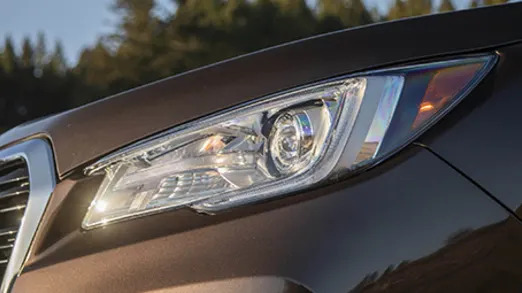
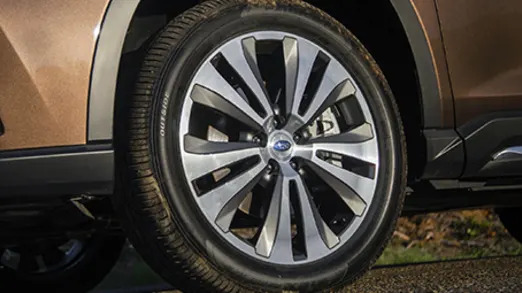
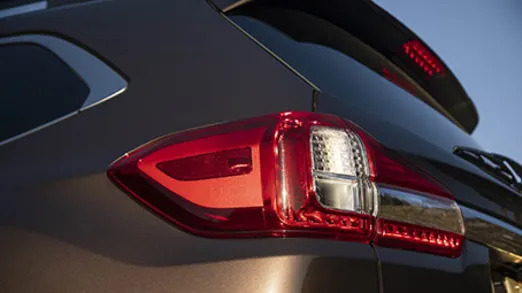
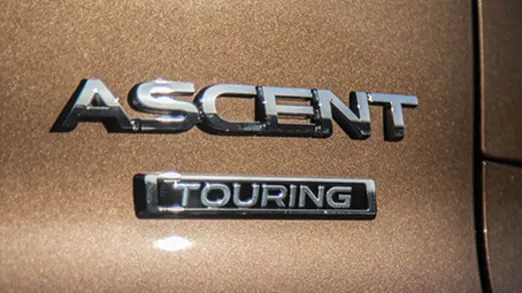
In person, the Ascent looks like an Outback-shaped balloon that's been blown up a bit too much. An oversize grille is flanked by big headlights at the top of the fascia and faux air intakes molded from matte black plastic at the bottom. It's bland, sure, but it's also not at all surprising that Subaru would err on the side of inoffensive after the design tragedy that was the face of the original B9 Tribeca. And while it definitely shares a strong family resemblance to the Outback, it's sufficiently different enough that buyers aren't likely to confuse the two on the showroom floor.
There are some interesting creases and bends in the Ascent's bodysides that add visual interest to what would otherwise be big, flat, sheetmetal stampings. And we have to commend Subaru for its restrained use of plastic underbody cladding, especially since the original Outback helped popularize that trend in the mid-1990s. There's a reasonable glass-to-metal ratio that helps the interior cabin feel airy and bright. Getting into the Ascent's third row is made easier by a large, squared off rear door.
A horizontal chrome strip visually connects big taillight clusters at the rear of the Ascent. The vertical orientation of the rear glass maximizes cargo space behind the third row. Whereas the sides are happily bereft of cladding, the rear bumper section is covered in the stuff, although the center section of plastic is actually a rather clean-looking cover for the optional trailer hitch.
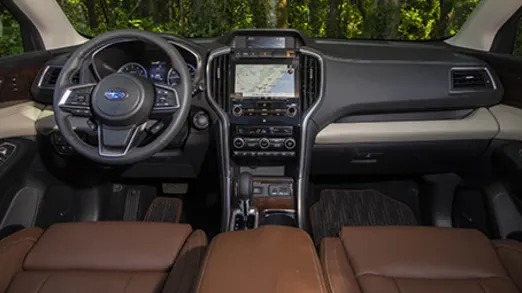
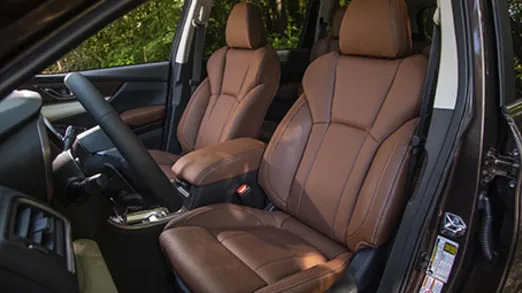
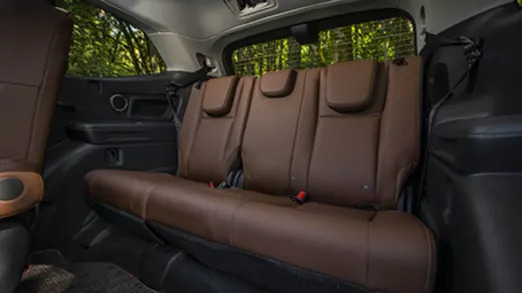

From the driver's seat, the Ascent's packaging continues to display Subaru's pragmatic philosophy to car design. All the gauges are easy to see and read at a glance, knobs and buttons are easy to locate — both those of the software-based touchscreen infotainment system and the physical ones on the steering wheel and center stack. We had a harder time than normal finding a comfortable driving position in the Ascent, but eventually settled with the steering wheel telescoped further away from the dash than normal and with the seat pulled in tight.We did eventually find a good fit, but we have a feeling that smaller drivers may find the driving position more awkward than larger drivers.
Compare the Ascent with two of the best-selling competitors in its class, the Honda Pilot and Toyota Highlander, and Subaru's offering looks perfectly sized on paper. In practice, a six-foot passenger will have plenty of room in the second row, which is adjustable for leg room and seatback angle. On upper trim levels, buyers can choose between a pair of captain's chairs or a three-passenger bench. There's no price difference between the two options, so it's really just a matter of need. We tested both setups and walked away thinking they were just about equal in terms of comfort.
Third-row passengers are treated better in the Ascent than in some competitors, like the Toyota Highlander, which feels extremely tight. If the middle-seat occupants are willing to slide their seats forward a bit, there's adequate legroom for a six-footer in the way back. Two reasonably sized adults could sit back there for a little while, if necessary, but their heads may be grazing the headliner. It's really more suitable for kids, who will enjoy a bevy of cupholders, tablet holders, and USB chargers to make the miles pass more quickly. There are 19 cupholders in all, which seems ridiculous until you consider that they'll end up acting as cubbies for the storage of a lot more than just cups.
Seven-passenger crossover buyers aren't likely to make ultimate purchase decisions based on driving dynamics, but Subaru has still baked some fun into the Ascent package. Steering is predictably light — much lighter than the Mazda CX-9, which serves as the fun-to-drive gold standard in this class — but offers a quick ratio and a reasonable amount of road feel. We never felt odd tugs at the steering wheel, but could sense some slippage from the tires when we pushed through corners on wet roads. Overall, the Ascent feels surefooted and secure, which are the kinds of attributes we'd call appropriate for vehicles designed primarily for schlepping families and cargo.
There are no sport modes to fiddle with in the Ascent, just a standard baseline setting, and that is just fine by us. This isn't a sporty car, so a single well-thought-out and sorted setup makes sense. The Ascent rides comfortably over harsh pavement but isn't sprung so softly that it wallows through corners, at least not when there's just a driver and single passenger onboard.
The Subaru Ascent has one lone available engine, a 2.4-liter, turbocharged, flat-four mated to a continuously variable transmission that sends 260 horsepower and 277 pound-feet of torque to all four wheels. Competitors like the Honda Pilot and Toyota Highlander get much larger V6 engines that buyers may feel more comfortable with on paper, but in reality, there's plenty of punch from Subie's turbo four. To drive that point home, Subaru shared with us a chart of 0-60 times based on its own independent testing. We couldn't verify the claims, but if true, the Ascent's 7.4-second performance puts it just behind the Pilot, but ahead of the V6-powered Highlander and Nissan Pathfinder. That being said, there were a few times we caught the engine flat footed on our drive and had to wait a second for the turbos to spin up, but we ended our drive thinking its output is sufficient.
There are a few turbocharged four-cylinder crossovers that directly compete with the Ascent, most notably the 2.3-liter EcoBoost-powered Ford Explorer and the Mazda CX-9. But, while the Mazda spins out a healthy 310 lb-ft of torque, it only makes 227 hp on regular-grade gas and requires premium to achieve its full 250-hp rating, and neither it nor the Ford can match the Ascent's tow rating of 5,000 pounds.
We were able to tow an Airstream trailer just shy of the Ascent's maximum of 5,000 pounds, and we found that it had no problem getting the load up to speed and back down again. Again, Subaru's internal testing suggests the Ascent has better passing power with a 5,000-pound load than most of its V6-powered competitors. We even did a slalom at a little over 20 miles per hour through some cones in a parking lot, and while that may seem slow, it's way faster than you'd ever attempt in real life without extenuating circumstances ... like, say, a blown tire carcass in the road in front of you. In any case, towing a properly loaded and configured trailer or boat up to the Ascent's maximum of 5,000 pounds shouldn't be a problem. Note that if you buy a base trim level Ascent, you'll be stuck with a 2,000-pound tow rating due to the absence of an oil cooler.
We're certain there will be a large swath of crossover buyers who dismiss the Subaru Ascent from consideration due solely to its four-cylinder engine. The omission of an optional six-cylinder is the one glaring item on the stat sheet to give shoppers pause, and Subaru does offer a 3.6-liter six-cylinder in its Outback (though we wouldn't be surprised to see that option disappear with the crossover-wagon's next redesign). Only time will tell if enough buyers accept the turbo four as a viable replacement for a larger-displacement six, but fortunately those who do will find that it offers adequate power.
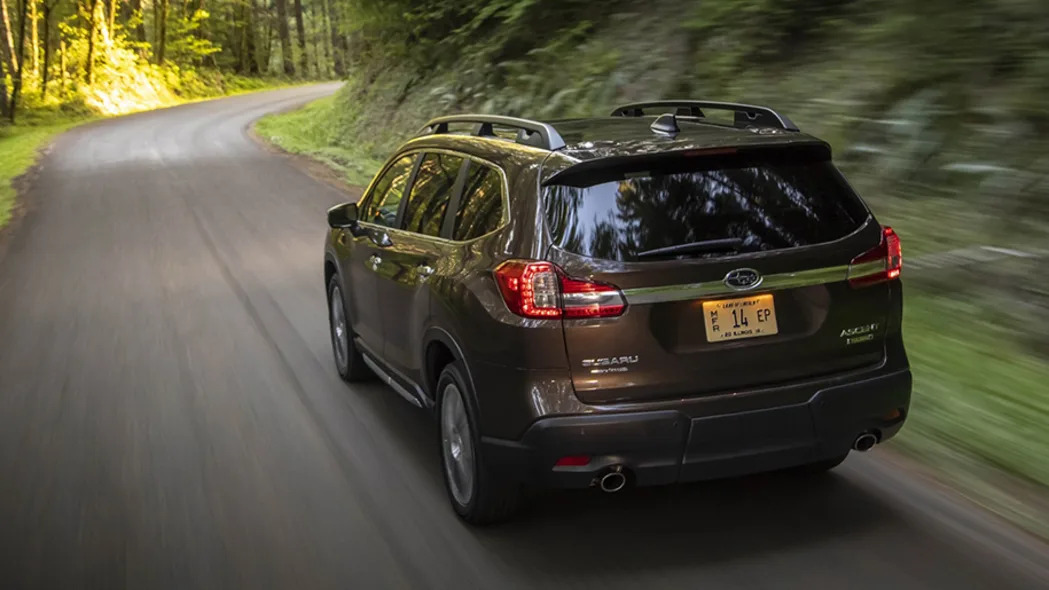
Similarly, some drivers may have had bad experiences with CVT transmissions in the past, and that may be a real deterrent to a test drive in the Ascent — especially when the competition mainly offers traditional automatics. Having driven our fair share of bad CVTs, which rev up and down unnecessarily or drone away uncomfortably at a fixed RPM, we understand the reticence. But Subaru seems to have sorted the CVT conundrum, building and programming a transmission that feels like a traditional automatic, with pre-programmed steps in the transmission's shift logic to simulate conventional gears. In the real world, it just works and doesn't get in the way of a good driving experience. And if you can't stand to let it do its thing in the background, there's an manual mode with standard steering-wheel-mounted paddle shifters that lets you shift through eight simulated gears.
The Ascent gets EPA estimated fuel economy ratings of 21 city, 27 highway, and 23 combined (drop one MPG for models with 20-inch wheels). That's an MPG or two better than the six-cylinder Pilot and Highlander, depending on options. Compared to other turbo four-cylinder crossovers, the Ascent matches the CX-9 (which makes full power with premium gas only) and easily beats the 2.3-liter EcoBoost Explorer's 18/25/21 rating (though the Explorer's engine does make more power).
As a final exercise at the end of our driving day, we took the Ascent to a quarry in rural Oregon to do some light off-roading and test Subaru's so-called X Mode, which is programmed for low-traction areas and steep up- and downhill slopes. As you can see in the video below, we certainly didn't put the Ascent through anything particularly hardcore — Wranglers needn't worry about sharing trail space with this particular Subaru — but we drove away confident that owners won't have any problem on the kinds of rutted dirt roads that lead to far-off secluded camping spots or snow-covered suburban driveways. And that's about as far off the beaten path as we'd expect the Ascent to go.
Subaru priced the Ascent right into the heart of the market. Its $32,970 base price puts it just over that of the front-wheel-drive Pilot but nearly a grand under a Pilot with all-wheel drive. For that base price, the Ascent comes standard with Subaru's EyeSight driver assist package, which includes Automatic Pre-Collision Braking, Adaptive Cruise Control, Lane Departure and Sway Warning. Android Auto and Apple CarPlay are also standard equipment. For $35,170, Premium Ascent models get 18-inch wheels, a larger 8.0-inch infotainment screen, and rear-seat climate controls. Limited models get 20-inch wheels, leather seats and LED headlights, among other things, for $39,970. Top-of-the-line Touring models start at $45,670 and include unique Java Brown leather upholstery, a heated steering wheel, heated and cooled front seats, an upgraded Harman Kardon audio system, and matte-finish wood trim.
The Subaru Ascent is well equipped to be a sales success. It's entering a booming three-row midsize crossover market and going up against a host of solid competitors. Very few people shopping for a crossover today will even remember the sad-sack Tribeca, but given Subaru's overall success in small and medium crossovers, we think buyers who can overlook the lack of a V6 long enough to take the Ascent for a test drive will be pleasantly surprised. Which is a very good thing. Because while everyone loves a feel-good story about second chances in life, there's just no way Subaru will convince buyers it deserves another mulligan.
Instead of trying to forget the unloved and slow-selling Tribeca, we get the sense that Subaru wants to keep that massive failure at the top of its collective mind. And we also got the sense that Subaru's engineers and product planners are confident that this time, they've hit a perfect drive off the tee — if not at Pebble Beach, then at least at one of the thousands of reasonably priced golf courses dotting the landscape of suburban America.
All the pieces of the crossover puzzle are in place: seven- and eight-passenger seating options, a sizable cargo area, standard all-wheel drive, and class-appropriate fuel mileage estimates. But, this being a Subaru, the manner with which the Ascent hits its targets varies a great deal from many of its competitors. In place of a naturally-aspirated V6, as found in the Honda Pilot or Toyota Highlander, is a turbocharged four-cylinder. And instead of sleek styling meant to attract eyeballs at the expense of usability, the Ascent is boxy, upright, and, well, kinda boring.




In person, the Ascent looks like an Outback-shaped balloon that's been blown up a bit too much. An oversize grille is flanked by big headlights at the top of the fascia and faux air intakes molded from matte black plastic at the bottom. It's bland, sure, but it's also not at all surprising that Subaru would err on the side of inoffensive after the design tragedy that was the face of the original B9 Tribeca. And while it definitely shares a strong family resemblance to the Outback, it's sufficiently different enough that buyers aren't likely to confuse the two on the showroom floor.
There are some interesting creases and bends in the Ascent's bodysides that add visual interest to what would otherwise be big, flat, sheetmetal stampings. And we have to commend Subaru for its restrained use of plastic underbody cladding, especially since the original Outback helped popularize that trend in the mid-1990s. There's a reasonable glass-to-metal ratio that helps the interior cabin feel airy and bright. Getting into the Ascent's third row is made easier by a large, squared off rear door.
A horizontal chrome strip visually connects big taillight clusters at the rear of the Ascent. The vertical orientation of the rear glass maximizes cargo space behind the third row. Whereas the sides are happily bereft of cladding, the rear bumper section is covered in the stuff, although the center section of plastic is actually a rather clean-looking cover for the optional trailer hitch.




From the driver's seat, the Ascent's packaging continues to display Subaru's pragmatic philosophy to car design. All the gauges are easy to see and read at a glance, knobs and buttons are easy to locate — both those of the software-based touchscreen infotainment system and the physical ones on the steering wheel and center stack. We had a harder time than normal finding a comfortable driving position in the Ascent, but eventually settled with the steering wheel telescoped further away from the dash than normal and with the seat pulled in tight.We did eventually find a good fit, but we have a feeling that smaller drivers may find the driving position more awkward than larger drivers.
Compare the Ascent with two of the best-selling competitors in its class, the Honda Pilot and Toyota Highlander, and Subaru's offering looks perfectly sized on paper. In practice, a six-foot passenger will have plenty of room in the second row, which is adjustable for leg room and seatback angle. On upper trim levels, buyers can choose between a pair of captain's chairs or a three-passenger bench. There's no price difference between the two options, so it's really just a matter of need. We tested both setups and walked away thinking they were just about equal in terms of comfort.
Third-row passengers are treated better in the Ascent than in some competitors, like the Toyota Highlander, which feels extremely tight. If the middle-seat occupants are willing to slide their seats forward a bit, there's adequate legroom for a six-footer in the way back. Two reasonably sized adults could sit back there for a little while, if necessary, but their heads may be grazing the headliner. It's really more suitable for kids, who will enjoy a bevy of cupholders, tablet holders, and USB chargers to make the miles pass more quickly. There are 19 cupholders in all, which seems ridiculous until you consider that they'll end up acting as cubbies for the storage of a lot more than just cups.
Seven-passenger crossover buyers aren't likely to make ultimate purchase decisions based on driving dynamics, but Subaru has still baked some fun into the Ascent package. Steering is predictably light — much lighter than the Mazda CX-9, which serves as the fun-to-drive gold standard in this class — but offers a quick ratio and a reasonable amount of road feel. We never felt odd tugs at the steering wheel, but could sense some slippage from the tires when we pushed through corners on wet roads. Overall, the Ascent feels surefooted and secure, which are the kinds of attributes we'd call appropriate for vehicles designed primarily for schlepping families and cargo.
There are no sport modes to fiddle with in the Ascent, just a standard baseline setting, and that is just fine by us. This isn't a sporty car, so a single well-thought-out and sorted setup makes sense. The Ascent rides comfortably over harsh pavement but isn't sprung so softly that it wallows through corners, at least not when there's just a driver and single passenger onboard.
The Subaru Ascent has one lone available engine, a 2.4-liter, turbocharged, flat-four mated to a continuously variable transmission that sends 260 horsepower and 277 pound-feet of torque to all four wheels. Competitors like the Honda Pilot and Toyota Highlander get much larger V6 engines that buyers may feel more comfortable with on paper, but in reality, there's plenty of punch from Subie's turbo four. To drive that point home, Subaru shared with us a chart of 0-60 times based on its own independent testing. We couldn't verify the claims, but if true, the Ascent's 7.4-second performance puts it just behind the Pilot, but ahead of the V6-powered Highlander and Nissan Pathfinder. That being said, there were a few times we caught the engine flat footed on our drive and had to wait a second for the turbos to spin up, but we ended our drive thinking its output is sufficient.
There are a few turbocharged four-cylinder crossovers that directly compete with the Ascent, most notably the 2.3-liter EcoBoost-powered Ford Explorer and the Mazda CX-9. But, while the Mazda spins out a healthy 310 lb-ft of torque, it only makes 227 hp on regular-grade gas and requires premium to achieve its full 250-hp rating, and neither it nor the Ford can match the Ascent's tow rating of 5,000 pounds.
We were able to tow an Airstream trailer just shy of the Ascent's maximum of 5,000 pounds, and we found that it had no problem getting the load up to speed and back down again. Again, Subaru's internal testing suggests the Ascent has better passing power with a 5,000-pound load than most of its V6-powered competitors. We even did a slalom at a little over 20 miles per hour through some cones in a parking lot, and while that may seem slow, it's way faster than you'd ever attempt in real life without extenuating circumstances ... like, say, a blown tire carcass in the road in front of you. In any case, towing a properly loaded and configured trailer or boat up to the Ascent's maximum of 5,000 pounds shouldn't be a problem. Note that if you buy a base trim level Ascent, you'll be stuck with a 2,000-pound tow rating due to the absence of an oil cooler.
We're certain there will be a large swath of crossover buyers who dismiss the Subaru Ascent from consideration due solely to its four-cylinder engine. The omission of an optional six-cylinder is the one glaring item on the stat sheet to give shoppers pause, and Subaru does offer a 3.6-liter six-cylinder in its Outback (though we wouldn't be surprised to see that option disappear with the crossover-wagon's next redesign). Only time will tell if enough buyers accept the turbo four as a viable replacement for a larger-displacement six, but fortunately those who do will find that it offers adequate power.

Similarly, some drivers may have had bad experiences with CVT transmissions in the past, and that may be a real deterrent to a test drive in the Ascent — especially when the competition mainly offers traditional automatics. Having driven our fair share of bad CVTs, which rev up and down unnecessarily or drone away uncomfortably at a fixed RPM, we understand the reticence. But Subaru seems to have sorted the CVT conundrum, building and programming a transmission that feels like a traditional automatic, with pre-programmed steps in the transmission's shift logic to simulate conventional gears. In the real world, it just works and doesn't get in the way of a good driving experience. And if you can't stand to let it do its thing in the background, there's an manual mode with standard steering-wheel-mounted paddle shifters that lets you shift through eight simulated gears.
The Ascent gets EPA estimated fuel economy ratings of 21 city, 27 highway, and 23 combined (drop one MPG for models with 20-inch wheels). That's an MPG or two better than the six-cylinder Pilot and Highlander, depending on options. Compared to other turbo four-cylinder crossovers, the Ascent matches the CX-9 (which makes full power with premium gas only) and easily beats the 2.3-liter EcoBoost Explorer's 18/25/21 rating (though the Explorer's engine does make more power).
As a final exercise at the end of our driving day, we took the Ascent to a quarry in rural Oregon to do some light off-roading and test Subaru's so-called X Mode, which is programmed for low-traction areas and steep up- and downhill slopes. As you can see in the video below, we certainly didn't put the Ascent through anything particularly hardcore — Wranglers needn't worry about sharing trail space with this particular Subaru — but we drove away confident that owners won't have any problem on the kinds of rutted dirt roads that lead to far-off secluded camping spots or snow-covered suburban driveways. And that's about as far off the beaten path as we'd expect the Ascent to go.
Subaru priced the Ascent right into the heart of the market. Its $32,970 base price puts it just over that of the front-wheel-drive Pilot but nearly a grand under a Pilot with all-wheel drive. For that base price, the Ascent comes standard with Subaru's EyeSight driver assist package, which includes Automatic Pre-Collision Braking, Adaptive Cruise Control, Lane Departure and Sway Warning. Android Auto and Apple CarPlay are also standard equipment. For $35,170, Premium Ascent models get 18-inch wheels, a larger 8.0-inch infotainment screen, and rear-seat climate controls. Limited models get 20-inch wheels, leather seats and LED headlights, among other things, for $39,970. Top-of-the-line Touring models start at $45,670 and include unique Java Brown leather upholstery, a heated steering wheel, heated and cooled front seats, an upgraded Harman Kardon audio system, and matte-finish wood trim.
The Subaru Ascent is well equipped to be a sales success. It's entering a booming three-row midsize crossover market and going up against a host of solid competitors. Very few people shopping for a crossover today will even remember the sad-sack Tribeca, but given Subaru's overall success in small and medium crossovers, we think buyers who can overlook the lack of a V6 long enough to take the Ascent for a test drive will be pleasantly surprised. Which is a very good thing. Because while everyone loves a feel-good story about second chances in life, there's just no way Subaru will convince buyers it deserves another mulligan.
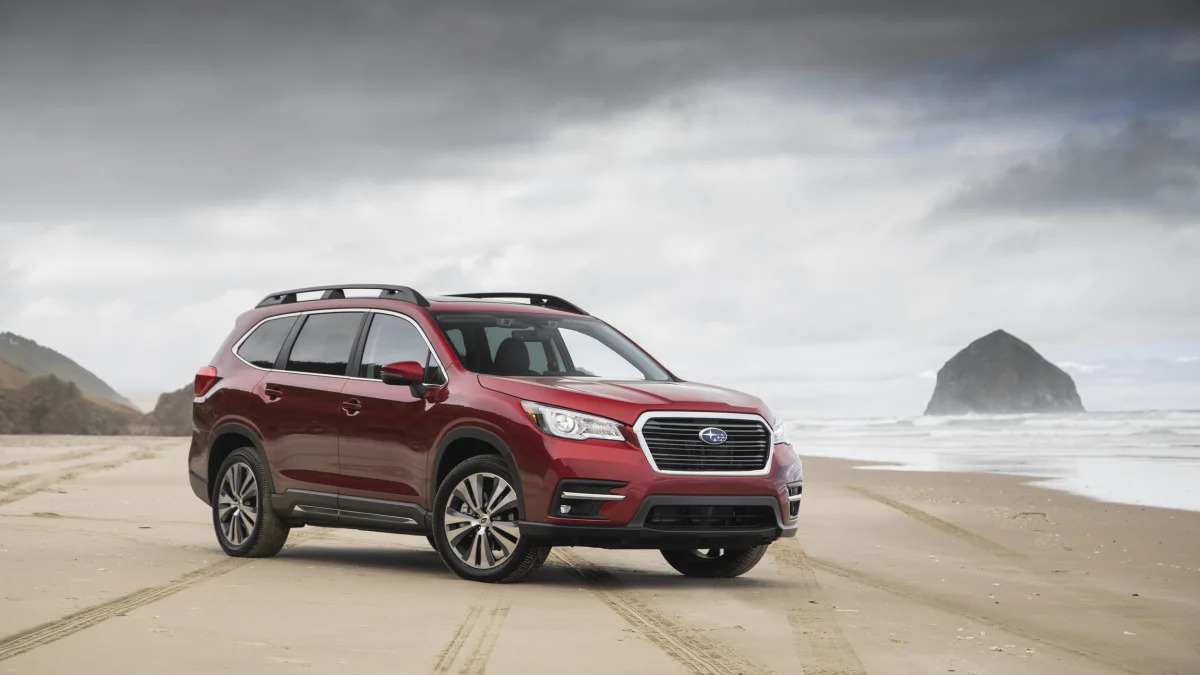









Sign in to post
Please sign in to leave a comment.
Continue